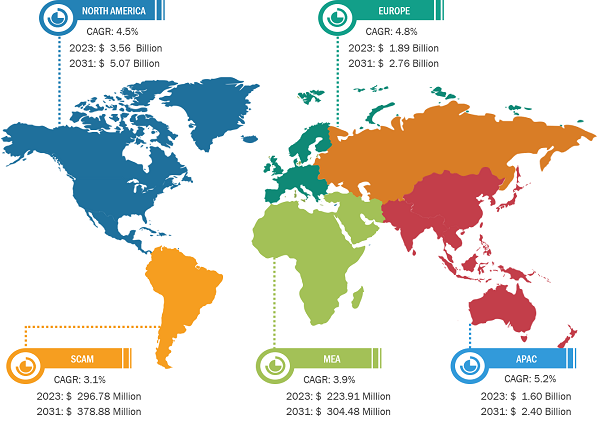X-Ray Diffractometer Segment to Bolster Nanoparticle Measurement Instrument Market Growth During 2023–2031
According to our new research study on "Nanoparticle Measurement Instrument Market Forecast to 2031 – Global Analysis – by Type and End User," the market is expected to grow from US$ 7.59 billion in 2023 to US$ 10.93 billion by 2031; it is anticipated to record a CAGR of 4.7% from 2023 to 2031. The nanoparticle measurement instrument market report emphasizes the trends prevalent in the global market, along with drivers and deterrents affecting its growth.
Increase in the applications of nanotechnology and the rising developments in analytical techniques are among the factors contributing to the growing nanoparticle measurement instrument market size. However, the high cost of instruments hampers the market growth. Further, the integration of artificial intelligence and machine learning is expected to bring new nanoparticle measurement instrument market trends in the coming years.
Nanoparticle Measurement Instrument Market Share, by Region, 2023 (%)
Nanoparticle Measurement Instrument Market Size and Forecast (2021 - 2031), Global and Regional Share, Trend, and Growth Opportunity Analysis Report Coverage: By Type (X-Ray Diffractometer, Scanning Electron Microscope, Atomic Force Microscope, Photon Correlation Spectroscope, Nanoparticle Surface Area Monitor, Transmission Electron Microscope, Condensation Particle Counter, Differential Mobility Analyzer, Scanning Mobility Particle Sizer, Nanoparticle Tracking Analyzer, Aerosol Particle Mass Analyzer, and Others), End User (Biotechnology Industry, Pharmaceutical Industry, Contract Research Organizations, and Others), and Geography (North America, Europe, Asia Pacific, South & Central America, and Middle East & Africa)
Nanoparticle Measurement Instrument Market Share by 2031
Download Free Sample
Source: The Insight Partners Analysis
Rise in Advancements in Analytical Techniques Propel Nanoparticle Measurement Instrument Market Growth
Higher sensitivity, accuracy, and throughput requirements of nanoparticle measurement and characterization drive advancements in various analytical techniques. Nanoparticle tracking analysis (NTA) has grown in popularity owing to its ability to detect and examine individual nanoparticles in solutions and to provide information on their size distribution and concentration. Multi-laser NTA is an advanced patented technology featuring three simultaneously operating lasers with independently adjustable power. Recent developments such as fluorescence NTA improve the ability to analyze fluorescently labeled nanoparticles, which is particularly useful in targeted and tracking studies. The development of nanoparticle measurement tools with modern analytical methods results in an upsurge in the use of nanotechnology in several sectors, particularly in medicine. Thus, the introduction of technologically advanced products for nanoparticle measurement drives the growth of the nanoparticle measurement instrument market.
The nanoparticle measurement instrument market analysis has been carried out by considering the following segments: type, end user, and geography. The market, based on type, is segmented into x-ray diffractometer, scanning electron microscope, atomic force microscope, photon correlation spectroscope, nanoparticle surface area monitor, transmission electron microscope, condensation particle counter, differential mobility analyzer, scanning mobility particle sizer, nanoparticle tracking analyzer, aerosol particle mass analyzer, and others. The transmission electron microscope segment held the largest share of the market in 2023. The same segment is expected to account for the highest CAGR from 2023–2031. With the evolution of different techniques for the synthesis of nanomaterials, researchers are persistently looking for more precise instruments for their characterization. X-ray diffraction (XRD) is emerging as the most widely used technique for distinguishing nanoparticles because of their ability to interact with the electrons of the inner shell of an atom. Due to this ability, various companies are developing XRD to measure colloidal nanoparticles. XRD analysis plays an essential role in pharmaceutical drug development processes. The technique aids in improving drug formulation, analyzing excipient compatibility, detecting bioavailability, and enhancing drug stability in different formulations, such as suspensions. As per the insights presented by Malvern Panalytical in 2024, the company has developed techniques to enable its Empyrean X-ray diffraction (XRD) instrument to perform small-angle X-ray scattering (SAXS) analysis in colloidal liquids and grazing incidence SAXS (GISAXS) on solids, allowing researchers to explore new possibilities without the need for a dedicated SAXS instrument. Thus, the increasing use of the XRD techniques in product development activities bolsters the demand for X-ray diffractometers.
The market, based on end user, is segmented into pharmaceutical industry, biotechnology industry, contract research organization, and others. The pharmaceutical industry segment held the largest nanoparticle measurement instrument market share in 2023. The pharmaceutical landscape has undergone a massive transformation with the emergence of new cost-effective technologies and more efficient manufacturing approaches. The employment of nanotechnology in medicine and drug research has the potential to bring significant advancements in disease diagnosis, treatment, and prevention. In recent years, nanoparticles have become essential in modern medicine as they are employed in clinical applications as contrast agents in imaging, carriers for drug and gene delivery into tumors, and so on. Nanoparticles enable analyses and therapies that cannot be performed otherwise. The expanding application of nanoparticles in the healthcare sector has led to the development of instruments to analyze and measure their different characteristics and functionalities in pharmaceutical preparations. For instance, the ARL EQUINOX X-ray diffractometer manufactured by Thermo Scientific is a compact instrument designed for industrial QA/QC, academic, and routine X-ray diffraction applications in the pharmaceutical sector.
The geographic scope of the Nanoparticle Measurement Instrument market report includes the assessment of the market performance in North America (US, Canada, and Mexico), Europe (Spain, UK, Germany, France, Italy, and Rest of Europe), Asia Pacific (South Korea, China, India, Japan, Australia, and Rest of Asia Pacific), the South & Central America (Brazil, Argentina, and Rest of South & Central America), and the Middle East & Africa (South Africa, Saudi Arabia, UAE, and Rest of Middle East & Africa). In terms of revenue, North America held the largest market share in 2023. Further, Asia Pacific is anticipated to record the highest CAGR in the market during the forecast period. The projected market growth in the region is attributed to factors such as increasing research in nanotechnology, supportive regulations for the development and commercialization of advanced nanoparticle measurement instruments, and increased funding for nanoparticle measurement instrument research.
Contact Us
Phone: +1-646-491-9876
Email Id: sales@theinsightpartners.com